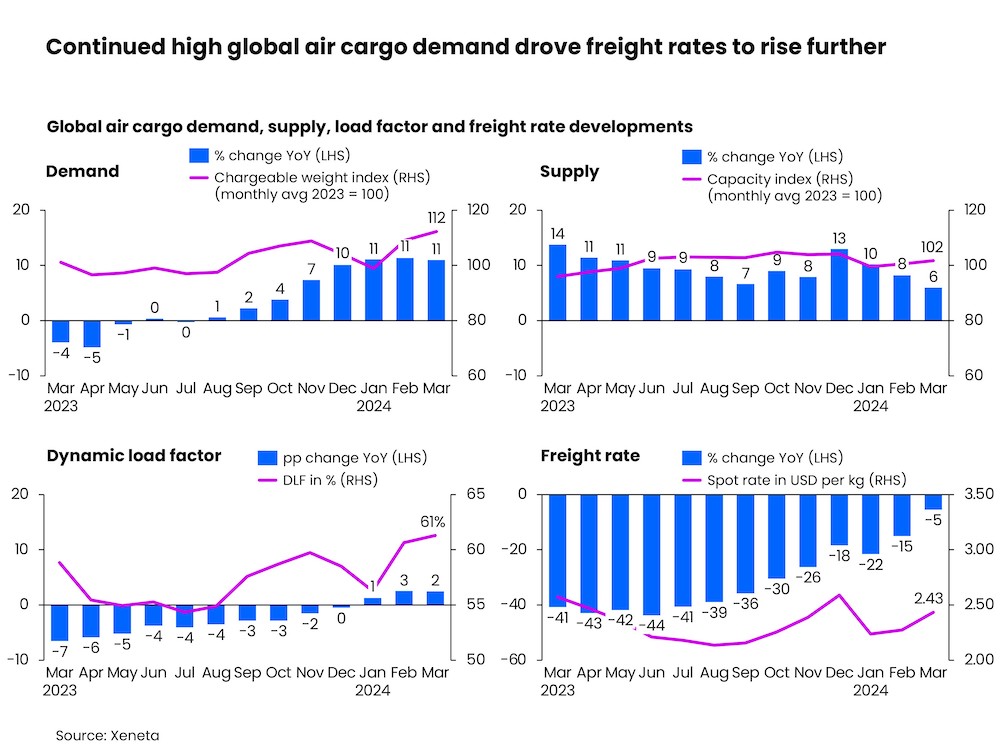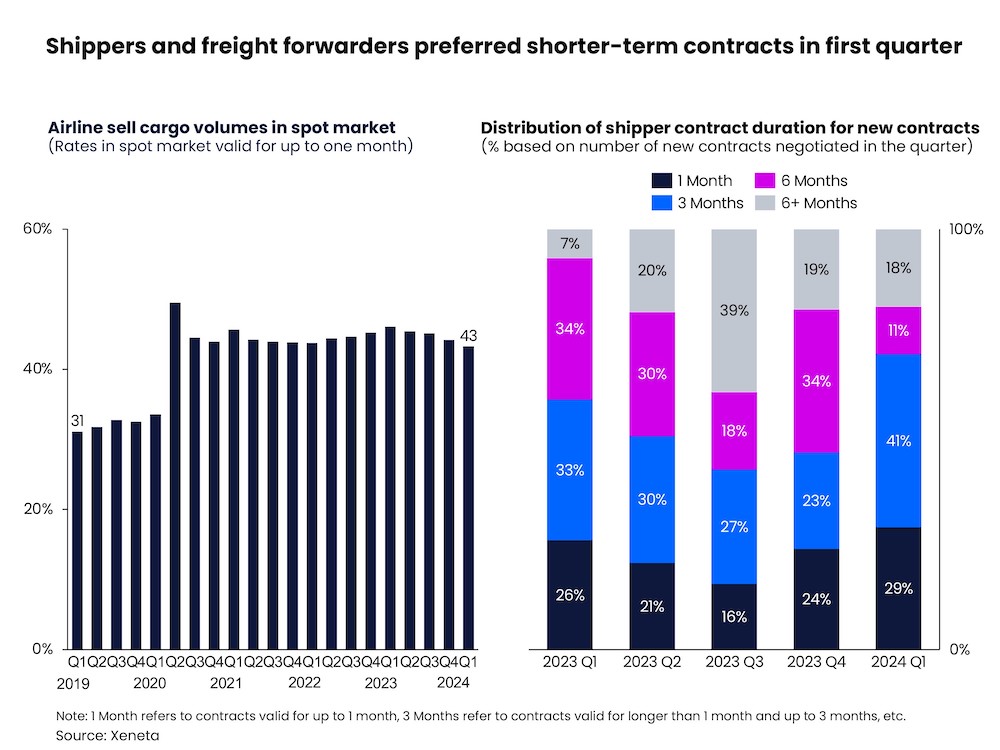‘Surprisingly resilient’ air cargo market enjoys a third consecutive month of +11% demand growth in March
Apr 04, 2024Global air cargo market demand rose +11% year-on-year for a third consecutive month in March as buoyant e-commerce volumes and concerns over the impact of conflict in the Red Sea region on ocean freight services delivered an unexpected first quarter bonus for forwarders and airlines, according to the latest weekly market data from Xeneta.
In what are typically weaker months of the year for the airfreight industry, these higher volumes outpaced growth in capacity supply in Q1, which increased by +8% YoY. In turn, this produced a jump in the global dynamic load factor, which is Xeneta’s measurement of cargo capacity utilization based on volume and weight of cargo flown alongside capacity available.
Load factor in the opening three months of 2024 rose +2% pts YoY to 59%, and March performance has shown similar growth, edging up to 61%.
“While this latest monthly data should be balanced against the lower base recorded in the corresponding month of 2023, when we saw weakened global manufacturing activities, Q1 2024 has still seen a surprisingly busy airfreight market. The level of demand in the first quarter doesn’t indicate a market which is running out of steam so far,” said Niall van de Wouw, Xeneta’s Chief Airfreight Officer.
“The question is, should we be surprised by it, or should we get used to it? Although the market didn’t benefit immediately, the Red Sea disruption was clearly a factor in these latest figures. Airfreight growth was primarily driven by increased volumes from the Middle East and South Asia as shippers shifted services from ocean to air to avoid Red Sea delays. We also cannot underestimate the importance of e-commerce growth, which shows no sign of abating on its most prominent lanes.”
Subsequently, the average global airfreight spot rate in March increased +7% from the previous month to USD 2.43 per kg.
On the corridor level, as highlighted, the Middle East and South Asia to Europe market continued to lead the growth of air cargo rates in March as the influx of air cargo demand caused by Red Sea concerns squeezed capacity on these lanes. The average spot rate on this corridor jumped +46% over February’s level to USD 2.82 per kg, up +71% year-on-year.
This was especially seen for the India outbound market, where the India to Europe air cargo spot rate in March rose 68% month-on-month to USD 3.38 per kg.
In contrast, the average ocean containerized spot rate on the India West Coast to North Europe lanes experienced a -9% decline in March after its peak in February, although this remained +340% above the level in December, prior to the Red Sea disturbance.
The Middle East and South Asia to US air cargo market followed suit. Its average spot rate of USD 4.03 per kg in March was up +35% month-on-month and +51% year-on-year.
In comparison, the air cargo spot rate from Europe to US increased only marginally by +3% month-on-month to USD 2.12 per kg due to this corridor being less impacted by the Red Sea.
The China outbound market experienced a decline in its spot rate versus February 2024 as the market cooled down after the Lunar New Year. The China to Europe spot rate decreased -3% month-on-month to USD 3.64 per kg. However, it increased +5% over the previous year, boosted primarily by e-commerce demand and the modal shift away from the Red Sea. Similarly, the China to US market spot rate of USD 4.06 per kg slipped down -2% month-on-month, although, year-on-year, growing e-commerce demand and delayed recovery of belly capacity contributed to a noticeable +15% average jump in spot freight rates.
The South America outbound market registered the largest decline among the top global air cargo corridors. As floral market demand eased, the South America to US air cargo spot rate dropped -12% from the previous month to USD 1.25 per kg in March, down -7% on the previous year. The South America to Europe market experienced a similar trend, with spot rates averaging USD 1.75 per kg, a fall of -18% month-on-month and -11% year-on-year.
March data shows freight forwarders continued to purchase a larger share of volumes on the spot market as they kept their options open pending an anticipated cooling down of the Red Sea disruption, and to benefit from the traditionally more imbalanced demand/supply ratio caused by the influx of airline belly capacity at the start of summer schedules. In the first quarter of 2024, the share of volumes in the spot market accounted for 43% of the total market – compared to 31% in the corresponding pre-pandemic era - as expectations of a ‘normalization’ of the cargo market prompted freight forwarders to take short-term risks in the spot market in the hope of longer-term gains.
Similarly, in the first quarter of 2024, more shippers pivoted away from longer-term global air cargo contracts to short-term capacity commitments, with three-month contracts accounting for 41% of all newly negotiated contracts in this quarter, up +18% pts from the previous quarter. The preference for six-month contracts declined 23% pts versus the previous quarter.
“The air cargo market has clearly enjoyed a stronger-than-anticipated start to the year, but there’s a different quarter coming along and more capacity coming in, so we do expect an overall downward pressure on load factor and rates, aside from selected corridors where the continuing rise of e-commerce and the residue of the Red Sea uncertainty will continue to boost rate levels.
“But this is now six months in-a-row that the air cargo market has been stronger than we expected. When is it going to slow down? Only time will tell but, right now, airfreight demand is surprisingly resilient.”


Similar Stories

Trump tariff hike on imports from China could boost air cargo
View Article
A2Z Drone Delivery launches world’s first multi-use BVLOS drone dock network
View Article
Lufthansa Cargo’s most extraordinary transports in 2024
View Article
Vertical Aerospace chooses Monolith as ‘AI for engineering’ partner
View Article
ECS Group signs groundbreaking TCM contract with JetSMART Airlines in South America
View Article[Freightos Weekly Update] Pre-Lunar New Year demand pushing transpacific rates up
ILA - USMX negotiations were set to restart today as the Jan. 15th strike deadline rapidly approaches, but the sides remain far apart on the role of port automation.
View ArticleGet the most up-to-date trending news!
SubscribeIndustry updates and weekly newsletter direct to your inbox!





